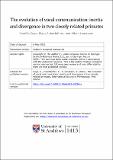Files in this item
The evolution of vocal communication : inertia and divergence in two closely related primates
Item metadata
| dc.contributor.author | Coye, Camille | |
| dc.contributor.author | Zuberbühler, Klaus | |
| dc.contributor.author | Lemasson, Alban | |
| dc.date.accessioned | 2023-05-03T23:54:32Z | |
| dc.date.available | 2023-05-03T23:54:32Z | |
| dc.date.issued | 2022-08-01 | |
| dc.identifier | 279477847 | |
| dc.identifier | 45fdab74-e523-4711-bba4-f73892d6e861 | |
| dc.identifier | 000790623500001 | |
| dc.identifier | 85129327363 | |
| dc.identifier.citation | Coye , C , Zuberbühler , K & Lemasson , A 2022 , ' The evolution of vocal communication : inertia and divergence in two closely related primates ' , International Journal of Primatology , vol. 43 , pp. 712-732 . https://doi.org/10.1007/s10764-022-00294-y | en |
| dc.identifier.issn | 0164-0291 | |
| dc.identifier.other | ORCID: /0000-0001-8378-088X/work/112711257 | |
| dc.identifier.uri | https://hdl.handle.net/10023/27502 | |
| dc.description | Funding: Research has been funded by the French Ministry of Research, the French University Institute (IUF), the National Agency for research (ANR ‘Orilang’), the European Union's Seventh Framework Programme (FP7/2007-2013) / ERC grant agreement n° 283871 and the Swiss National Science Foundation (310030_185324). | en |
| dc.description.abstract | Primate vocal repertoires change slowly over evolutionary time, making them good indicators of phylogenetic relatedness. Occasionally, however, socio-ecological pressures cause rapid divergence, even in closely related species, but overall it remains unclear how inertia and divergence interact to evolve species-specific vocal repertoires. We addressed this topic with a study of two closely related sympatric guenons, Diana monkeys (Cercopithecus diana) and Campbell’s monkeys (C. campbelli). We compiled published, long-term data to compare repertoire size, call morphology and combinations in these species, and complemented these data with new, machine-learning based acoustic analyses of calls made by three individuals of each species to assess the degree of individual differences in call types. In line with the phylogenetic inertia hypothesis, we found similarities in the overall call repertoires, with six of eight vocal units shared between the two species. The non-shared units all functioned in the predation context, suggesting that alarm calls are especially susceptible to evolutionary change. In addition, Campbell’s monkeys (the species more exposed to predation) produced more inconspicuous calls throughout their repertoire than Diana monkeys, suggesting that predation has a generalised impact on vocal structure. Finally, although both species combined calls flexibly, this feature was more prominent in Diana monkeys that live in larger groups and are less exposed to ground predators. This suggests that, although predation appears to favour the diversification of alarm call repertoires, it also inhibits the emergence of vocal combinations in social communication. We conclude that interspecies competition, and the niche specialisation this creates, is a key evolutionary driver of primate vocal behaviour. These conclusions are preliminary since they are based on comparing only two species but open a promising avenue for broader-scale comparisons. | |
| dc.format.extent | 21 | |
| dc.format.extent | 1083399 | |
| dc.language.iso | eng | |
| dc.relation.ispartof | International Journal of Primatology | en |
| dc.subject | Cercopithecus | en |
| dc.subject | Caller identity | en |
| dc.subject | Call use | en |
| dc.subject | Vocal evolution | en |
| dc.subject | Predation | en |
| dc.subject | Combinatoriality | en |
| dc.subject | BF Psychology | en |
| dc.subject | NDAS | en |
| dc.subject | MCC | en |
| dc.subject.lcc | BF | en |
| dc.title | The evolution of vocal communication : inertia and divergence in two closely related primates | en |
| dc.type | Journal article | en |
| dc.contributor.institution | University of St Andrews. Institute of Behavioural and Neural Sciences | en |
| dc.contributor.institution | University of St Andrews. Centre for Social Learning & Cognitive Evolution | en |
| dc.contributor.institution | University of St Andrews. School of Psychology and Neuroscience | en |
| dc.identifier.doi | 10.1007/s10764-022-00294-y | |
| dc.description.status | Peer reviewed | en |
| dc.date.embargoedUntil | 2023-05-04 |
This item appears in the following Collection(s)
Items in the St Andrews Research Repository are protected by copyright, with all rights reserved, unless otherwise indicated.

